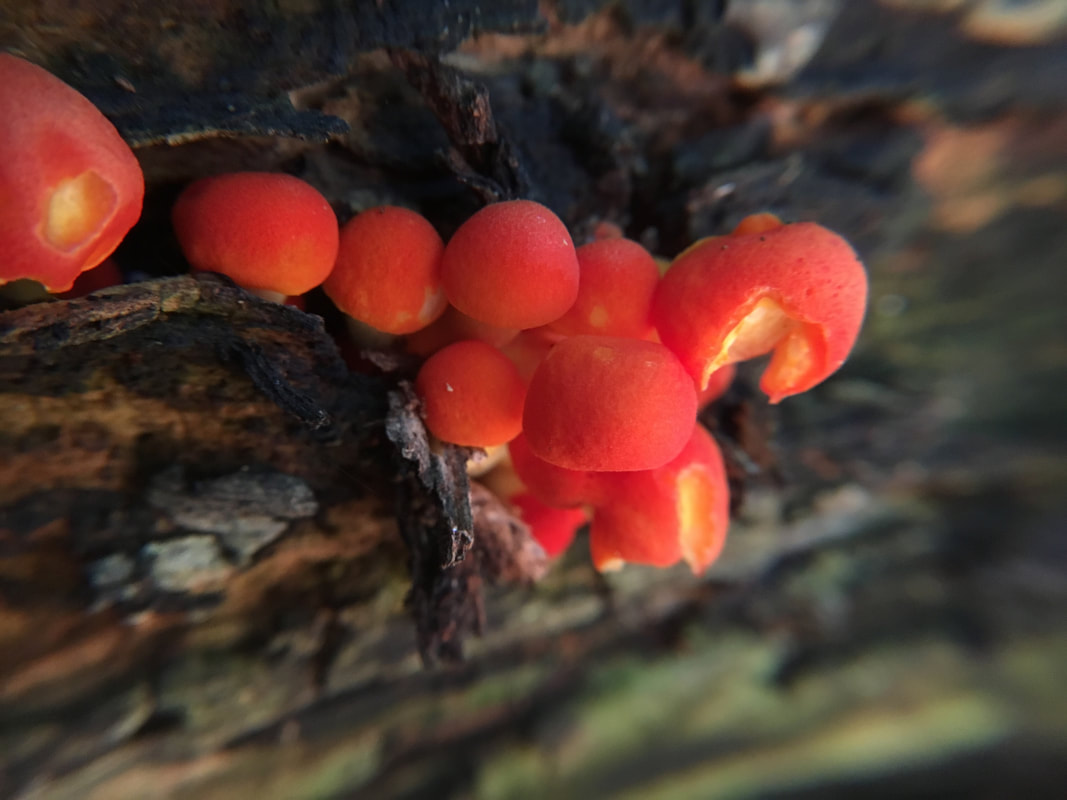|
Mycobank Taxonomy: Fungi, Dikarya, Basidiomycota, Agaricomycotina, Agaricomycetes, Agaricales, Pluteaceae, Pluteus Some fungi are "rare" simply because they are obscure and nobody besides myconerds looks for them. P. aurantiorugosis, on the other hand, is a gorgeous, photogenic mushroom. Despite the fact it stands out, it is seldom documented, and thus can be regarded as truly rare. For example, Michael Kuo from mushroomexpert.com has only found it once in 20 years of mushroom hunting. I am continuously surprised by the forest behind my house. It's a cruddy place - buckthorn, honeysuckle, and box elder run the woods; trash is scattered about or heaped into dumpy piles; and invasive fungal pathogens are devastating the hardwood trees. Yet, it is full of treasures. In addition to the truffle I recently found, it is also where I discovered this mushroom. The scarlet-red fruiting bodies were growing off the end of a fallen, decorticated trunk. I puzzled over them for a long time. They were so distinct yet they didn't fit any description in my head. Once I noticed the free, pinkish gills, I knew it was a Pluteus species and identification was only a quick Google search away. To my surprise, this was the first documented encounter of P. aurantiorugosis in Michigan since the 1970s!
2 Comments
Mycobank Taxonomy: Fungi, Dikarya, Basidiomycota, Agaricomycotina, Agaricomycetes, Agaricales, Agaricaceae, Calvatia Calvatia gigantea is not a good mushroom. It can be so huge, such a massive marshmallow, that I want so badly for it to be tasty. I’ve baked it as pizza crust, sautéed it, and deep fried it as puffball parmesan, but it’s never good. The smaller the ratio of puffball to other things (fried bits, sauce, veggies) the better. I’m no mathematician, but I think if you take that property to it’s limit, the best puffball dish is one that does not contain any puffball at all. In my opinion, this mushroom smells and tastes chemically, like a permanent marker. Chalk it up to bad cooking or subpar specimens, but I would argue that I’m a pretty good cook and that I’ve selected the finest, youngest, whitest, firmest, maggotless puffballs around, but Calvatia gigantea still makes good food taste bad. It’s not a good mushroom.
Mycobank Taxonomy: Fungi, Dikarya, Ascomycota, Pezizomycotina, Pezizomycetes, Pezizales, Tuberaceae, Tuber I did it! I’ve eaten 1001 different mushrooms! What, you thought my goal was to eat “one thousand and one” mushrooms? That’s absurd! Isn’t everything binary in this age of computers? To celebrate the accomplishment of the binary version of this project (1001 = 9), I endeavored into the exquisitely funky world of truffles. While some people make the distinction between “true truffles” (Tuber spp.) and “false truffles” (everything else that grows underground), I’ll refer to them all as truffles. Recently, I learned that truffles are all around us. There are actually over 40 Tuber species native to North America (Guevara et al. 2013 listed 38, and more have been described since) and if you consider underground fungi in other genera, there might be hundreds of species present in the United States!
|
PermalinksProject Introduction Top EdiblesHericium coralloides
Laetiporus sulphureus Morchella americana Polyporus umbellatus Suillus ampliporus Archives
April 2023
Categories |
|
|
Terms of Use, Liability Waiver, and Licensing
The material on aldendirks.com is presented for general informational and educational purposes only, and under no circumstances is to be considered a substitute for identification of an actual biological specimen by a person qualified to make that judgment. Some fungi are poisonous; please be cautious. All images on this website are licensed under Attribution-NonCommercial-NoDerivatives 4.0 International (CC BY-NC-ND 4.0). |



 RSS Feed
RSS Feed




